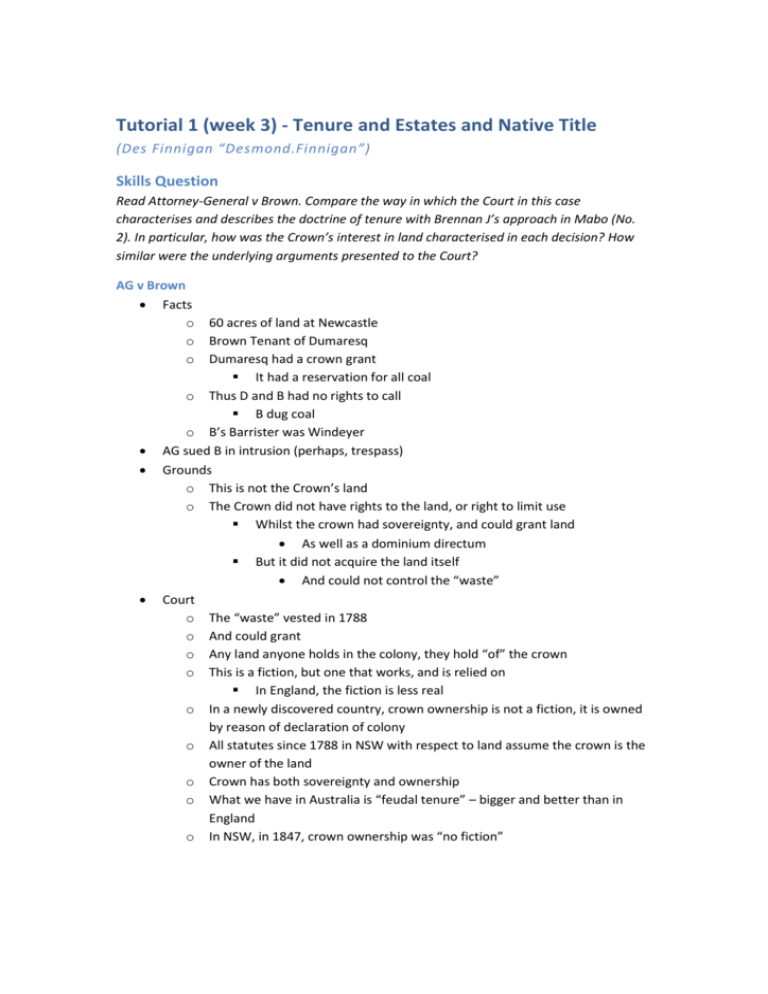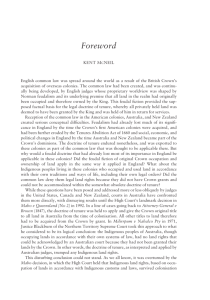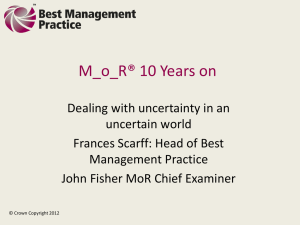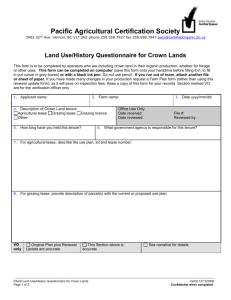
Tutorial 1 (week 3) - Tenure and Estates and Native Title
(Des Finnigan “Desmond.Finnigan”)
Skills Question
Read Attorney-General v Brown. Compare the way in which the Court in this case
characterises and describes the doctrine of tenure with Brennan J’s approach in Mabo (No.
2). In particular, how was the Crown’s interest in land characterised in each decision? How
similar were the underlying arguments presented to the Court?
AG v Brown
Facts
o
o
o
60 acres of land at Newcastle
Brown Tenant of Dumaresq
Dumaresq had a crown grant
It had a reservation for all coal
o Thus D and B had no rights to call
B dug coal
o B’s Barrister was Windeyer
AG sued B in intrusion (perhaps, trespass)
Grounds
o This is not the Crown’s land
o The Crown did not have rights to the land, or right to limit use
Whilst the crown had sovereignty, and could grant land
As well as a dominium directum
But it did not acquire the land itself
And could not control the “waste”
Court
o The “waste” vested in 1788
o And could grant
o Any land anyone holds in the colony, they hold “of” the crown
o This is a fiction, but one that works, and is relied on
In England, the fiction is less real
o In a newly discovered country, crown ownership is not a fiction, it is owned
by reason of declaration of colony
o All statutes since 1788 in NSW with respect to land assume the crown is the
owner of the land
o Crown has both sovereignty and ownership
o What we have in Australia is “feudal tenure” – bigger and better than in
England
o In NSW, in 1847, crown ownership was “no fiction”
In AG v Brown, tenure in Australia is held to by more “real” than in the UK, since at the time
of settlement, land did transfer, in full, to the commonwealth, where in the UK the transfer
was a legal fiction. As such, all land in Australia was crown land, which could be granted.
However, this original transfer of land extinguished all previous claims on land in Australia:
actually, since Australia was considered “Terra Nullius” it was not thought to extinguish
native title, but to create crown title where there was none before.
In Mabo (No. 2), the political context was changing: there continued to be a greater push
towards recognizing native title rights (although the Gove land rights case failed, native title
had been found in PNG). There were two interests here, the crown’s paramount lordship
over the land and the indigenous, native title right to the land. Since tenure could not be
removed (so as not to “fracture the skeleton of the common law”, radical title was invented.
Here, the crown has sovereignty over all land, and power to exercise land rights, but it does
not have literal “ownership” over every parcel of land in Australia. The right is not exercised
until land is granted. Therefore, until fees simple are created, native title right is not
extinguished. This fiction of “radical title” allowed tenure and native title to coexist.
There was a shift, from AG to Mabo, in the crown’s interest, from being an actual land right,
with an actual interest in every plot of land, to radical title, where there was a right to
exercise power, but no actual interest in every specific plot until the power is exercised.
The arguments posed to the bench in both cases were almost identical, but attitudes and
international norms had changed, and precedents had occurred which would allow for
native title.
Tutorial Questions
1. Describe the doctrine of tenure. What is an allodial system of land holding? How
does it differ from land held under the doctrine of tenure?
a. Tenure occurs whereby land is owned “of” a third party (in Australia, the
crown, who is a paramount lord: any other interestes are held “of” the
crown).
i. No-one holds land absolutely
ii. Tenure describes the relationship between tenant and lord
b. An allodial system of land holding is where land is owned absolutely.
2. How does the doctrine of native title relate to that of the doctrine of tenure? To what
extent is the former reliant on the latter?
a. They are linked, since the classical application of the tenurial system would
see that native title was extinguished upon Australia’s settlement and the
arrival of the system of tenure.
i. Native title is sui generis.
ii. Native title act regulates how it works
b. Native title is now reliant on tenure, since Radical Title allows it to exist.
However, it may be that it would be stronger in an allodial system.
3. What does it mean to say that native title is not ‘of’ the common law, but recognised
by the common law? Do you agree with this statement? If not, why not?
a. Land held “of” the common law is held according to the doctrine of tenure,
e.g. “of” the crown.
b. Native title land is recognized according to tradition, and is outside of the
tenurial system (it is not “of” the crown, (not devolved)). As such, the
common law does not create the native title right to land, but merely
recognizes the right created outside of the common law system, and seeks
to preserve it.
i. It comes form another legal system
ii. It is given recognition and form in the common law if it conforms
with the requirements of native title docrine:
1. Continuouse and uninterrupted use
2. Customs and traditions must be shown to be excercised in
substantially the same manner since sovereignty (1788)
3. It must be held by a group descended from the original
holders
4. According to the doctrine of estates, one does not own the land, but an estate in
land. A fee simple estate is considered the most ample or complete estate in land.
What does it mean to have an estate in fee simple? What are the characteristics of
an estate in fee simple? What can the owner of a fee simple estate in land do with
the land? What kind of restrictions are there on ownership? Given these restrictions,
do owners still have exclusive possession?
a. An estate in fee simple is an estate owned directly “of” the crown
b. It is a bundly of rights in respect of land, and has the following
characteristics
i. It is inheritable (“fee”) and is thus of uncertain duration
ii. It has no restrictions on the inheritance (“simple”)
iii. It comes with 11 rights, the most important of which are
occupation, possession and alienation
c. It has the following limitations:
i. Others can enter the land before being asked to leave
ii. Any rights reserved by original grant
iii. Anything that is “most excellent”
iv. Things vested in the crown by legislation
1. E.g. mining legislation
2. Petroleum legislation
d. Owners have exclusive possession unless another right interferes with it.
Does this make it non-exclusive?
5. Why does an estate in fee simple extinguish native title?
a. Once the commonwealth excercizes its radical title and grants land, any land
right outside of the common law is superseded. Radical title becomes actual
ownership, and, thus, native title is extinguished.
b. Excercising “radical title” bring the land within the common law
c. It gives exclusive possession that is legally inconsistant with the continuation
of native title
d. Once extinguishment occurs, it is forever, if a fee simple ends, native title
does not revive
6. Do you think native title can be characterised as a proprietary interest? What
incidents of property does native title have? What are the consequences of
recognising or not recognising native title as property?
a. I do not think it is proprietary (No, according to Dean, and Gaudron)
b. Whilst the land may be used, it is inaleanable, and it may only be used in
specific ways e.g. no commercial use.
i. It is also communal
c. Since native title is not property, the incentive to fight for it is diminished.
Note, in countries such as Canada, it has been seen as a proprietary right, to
great successs.









